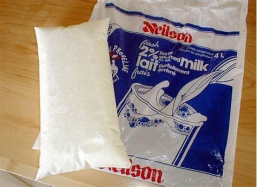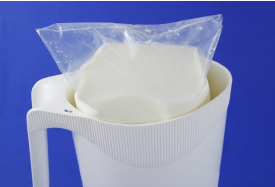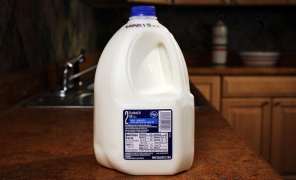英語ネイティブの翻訳者から、カナダで販売されている袋入りの牛乳とそれにまつわるプラスチックごみの課題について話を聞きました。
2020年10月2日 14時48分
※英語原文は日本語記事の下に掲載しています。
私は袋に入って売られている牛乳を飲んで育ちました。
たいてい牛乳は4袋組(1袋につき1リットル)で、
食料品店では色付きの大きな袋に入れて売られています。
私は袋を牛乳袋ホルダーに入れたら、袋が安定するように
ホルダーをキッチンカウンターの上でトントンとたたき、
冷蔵庫に入れる前に袋の角をはさみで切っていました。
私はオンタリオ州で育ったため、オンタリオ以外の場所を訪れるまで、
カナダ西部やアメリカで(そして日本でも)牛乳が瓶やパックで
売られていることを知りませんでした。


左の写真で上にあるのは1リットル入りの牛乳袋で、下にあるのはその牛乳袋が入っている大きな袋です。右側の写真は一般的な牛乳袋ホルダーです(私はいつも白いホルダーを使っていましたが、今では色付きのものやパーソナライズされたホルダーを選ぶ人たちもいます)。
このCBC short broadcastで伝えているように、
牛乳は1960年代までガラス瓶に入れられて販売されていました。
しかし、1960年代後半にカナダは帝国単位(ガロン、クォーター、パイント)から
メートル法(リットル)に変わり、この切り替えにより
食品業界の製造者たちはパッケージングの課題に直面しました。
1クォートのガラス瓶から1リットルのガラス瓶に変更するのは大きな費用がかかるため、オンタリオ州やカナダ東部の他の州ではこの変化に適応するために、
コストパフォーマンスが高い方法としてプラスチックの牛乳袋が使用されました。
一方で、カナダ西部ではプラスチックのボトルや厚紙のパックへ切り替わりました。
1ガロンのプラスチックボトルは、アメリカで好まれて使用されています
(私自身、アメリカに8年間ほど住んでいました)。

上の写真はアメリカで売られている一般的な1ガロン入りの牛乳ボトルです。
これらのボトルは穴があきづらいですが、より多くのプラスチックごみを排出します。
プラスチック容器へ切り替えが行われると、
ごみ埋め立て地にプラスチックごみがたまるという深刻な問題が確実に起こります
(日本で行われているごみ焼却とは対照的で、
北米ではごみ埋め立て地でのごみ処理が一般的です)。
しかし最近では、トロントのMilkbags UnlimitedのようなNGO団体が現れ、
牛乳袋をリサイクルし、ホームレスや被災者のためにマットレスを作っています。
このビデオで説明されているように、空の牛乳袋の枠全体を使って折り畳み、
カットしたものを編んでマットレスを作ります。
牛乳袋は、枕の詰め物や編み込みのハンドバッグにも使用されています。
世界中でプラスチックごみの排出量が増えたことで、
水源が汚染され、太平洋にプラスチックごみが集まって
島のように浮かぶマイクロプラスチック問題の原因となっています。
私たちの社会において増えるプラスチックごみに対処するためには、
革新的な解決法を模索するために、一般の人々が協力し合う必要があります。
日本はプラスチックごみを再利用するために重要なリサイクル技術を開発しましたが、
自分の地域コミュニティでも、プラスチックごみに対する
革新的な解決法を考えるために協力してみましょう。
そうした取り組みがプラスチックごみの拡散を防ぎ、
あなたの周りで困っている人たちを助けるためにも役立つはずです。
プラスチック容器をリサイクルするための面白いアイディアを
紹介しているビデオがありますので、ぜひご覧ください!
私は袋に入って売られている牛乳を飲んで育ちました。
たいてい牛乳は4袋組(1袋につき1リットル)で、
食料品店では色付きの大きな袋に入れて売られています。
私は袋を牛乳袋ホルダーに入れたら、袋が安定するように
ホルダーをキッチンカウンターの上でトントンとたたき、
冷蔵庫に入れる前に袋の角をはさみで切っていました。
私はオンタリオ州で育ったため、オンタリオ以外の場所を訪れるまで、
カナダ西部やアメリカで(そして日本でも)牛乳が瓶やパックで
売られていることを知りませんでした。


左の写真で上にあるのは1リットル入りの牛乳袋で、下にあるのはその牛乳袋が入っている大きな袋です。右側の写真は一般的な牛乳袋ホルダーです(私はいつも白いホルダーを使っていましたが、今では色付きのものやパーソナライズされたホルダーを選ぶ人たちもいます)。
このCBC short broadcastで伝えているように、
牛乳は1960年代までガラス瓶に入れられて販売されていました。
しかし、1960年代後半にカナダは帝国単位(ガロン、クォーター、パイント)から
メートル法(リットル)に変わり、この切り替えにより
食品業界の製造者たちはパッケージングの課題に直面しました。
1クォートのガラス瓶から1リットルのガラス瓶に変更するのは大きな費用がかかるため、オンタリオ州やカナダ東部の他の州ではこの変化に適応するために、
コストパフォーマンスが高い方法としてプラスチックの牛乳袋が使用されました。
一方で、カナダ西部ではプラスチックのボトルや厚紙のパックへ切り替わりました。
1ガロンのプラスチックボトルは、アメリカで好まれて使用されています
(私自身、アメリカに8年間ほど住んでいました)。

上の写真はアメリカで売られている一般的な1ガロン入りの牛乳ボトルです。
これらのボトルは穴があきづらいですが、より多くのプラスチックごみを排出します。
プラスチック容器へ切り替えが行われると、
ごみ埋め立て地にプラスチックごみがたまるという深刻な問題が確実に起こります
(日本で行われているごみ焼却とは対照的で、
北米ではごみ埋め立て地でのごみ処理が一般的です)。
しかし最近では、トロントのMilkbags UnlimitedのようなNGO団体が現れ、
牛乳袋をリサイクルし、ホームレスや被災者のためにマットレスを作っています。
このビデオで説明されているように、空の牛乳袋の枠全体を使って折り畳み、
カットしたものを編んでマットレスを作ります。
牛乳袋は、枕の詰め物や編み込みのハンドバッグにも使用されています。
世界中でプラスチックごみの排出量が増えたことで、
水源が汚染され、太平洋にプラスチックごみが集まって
島のように浮かぶマイクロプラスチック問題の原因となっています。
私たちの社会において増えるプラスチックごみに対処するためには、
革新的な解決法を模索するために、一般の人々が協力し合う必要があります。
日本はプラスチックごみを再利用するために重要なリサイクル技術を開発しましたが、
自分の地域コミュニティでも、プラスチックごみに対する
革新的な解決法を考えるために協力してみましょう。
そうした取り組みがプラスチックごみの拡散を防ぎ、
あなたの周りで困っている人たちを助けるためにも役立つはずです。
プラスチック容器をリサイクルするための面白いアイディアを
紹介しているビデオがありますので、ぜひご覧ください!
~編集後記~
カナダには袋入りの牛乳が存在するという情報を知り、カナダ出身の翻訳者に今回のテーマをリクエストして記事を書いてもらいました。
袋入り牛乳が誕生した背景から、その袋を再利用する取り組みまで、深い話を聞くことができ、とても勉強になりました。
プラスチックごみ問題から世界を救うためには、やはり一人一人の意識が大切ですね。
普段の生活から見直せることがたくさんありそうなので、
私もアイディアを模索していきたいと思います。
袋入り牛乳が誕生した背景から、その袋を再利用する取り組みまで、深い話を聞くことができ、とても勉強になりました。
プラスチックごみ問題から世界を救うためには、やはり一人一人の意識が大切ですね。
普段の生活から見直せることがたくさんありそうなので、
私もアイディアを模索していきたいと思います。
(写真上記)
Bagged Milk in Canada: An Environmental Challenge and Grassroots Solutions
I grew up drinking from milk that came in bags. There are usually 4 bags of milk—one litre each—that come in a larger coloured bag sold at the grocery store. I would put one bag in a milk bag holder, bang it on the counter to settle into the holder, and snip a corner off before storing it in the fridge. I grew up in Ontario and I never realized that milk was sold in jugs or cartons in Western Canada and the United States (and Japan!) until I travelled outside of Ontario.
(写真上記)
Pictured on the left is a one-liter milk bag shown on top of the larger milk bag. Pictured on the right is a standard milk bag holder (I’ve always used white milk bag holders, but some people choose coloured or personalized milk bag holders now.).
As this CBC short broadcast states, milk used to be sold in glass bottles up until the 1960s. But Canada switched from the imperial system (gallons, quarters, and pints) to the metric system (litres) in the late 1960s, and the switchover posed packaging challenges to manufacturers across the food industry. It was very costly to change from one-quart glass bottles to one-litre glass bottles, so plastic was used to accommodate this change in a cost effective manner in Ontario and other provinces in Eastern Canada, while Western Canada switched to plastic jugs and cardboard cartons. One gallon plastic jugs are favoured in the United States (where I also lived for about 8 years).
(写真上記)
Pictured above is a common one-gallon milk jug sold in the United States. These are more puncture resistant, but produce more plastic waste.
Switching to plastic containers would obviously pose a serious problem with plastic waste accumulating in landfills (disposal of garbage in landfills is a common practice in North America, as opposed to incinerating garbage that is practiced in Japan). However, recently, NGOs, like Milkbags Unlimited in Toronto, have emerged that recycle milk bags into making mattresses for the homeless and for disaster victims. They fold, cut and weave the empty milk bags across frames to create mattresses as this video demonstrates. Milk bags have also been used to stuff pillows and weave into handbags.
With the increasing amount of plastic waste accumulating around the world and contributing to the microplastics pollution problem contaminating water sources and forming a giant plastic island in Pacific Ocean, it’s up to regular people to organize together to find innovative solutions to deal with increasing plastic waste in our societies.
Japan has developed important recycling techniques for reclaiming old plastic waste; but, maybe you can help out in your local community to find innovative solutions for plastic waste that both help prevent the spread of plastic waste and help out those in need around you. Here’s a video offering interesting tips on recycling plastic containers. Give it a shot!
I grew up drinking from milk that came in bags. There are usually 4 bags of milk—one litre each—that come in a larger coloured bag sold at the grocery store. I would put one bag in a milk bag holder, bang it on the counter to settle into the holder, and snip a corner off before storing it in the fridge. I grew up in Ontario and I never realized that milk was sold in jugs or cartons in Western Canada and the United States (and Japan!) until I travelled outside of Ontario.
(写真上記)
Pictured on the left is a one-liter milk bag shown on top of the larger milk bag. Pictured on the right is a standard milk bag holder (I’ve always used white milk bag holders, but some people choose coloured or personalized milk bag holders now.).
As this CBC short broadcast states, milk used to be sold in glass bottles up until the 1960s. But Canada switched from the imperial system (gallons, quarters, and pints) to the metric system (litres) in the late 1960s, and the switchover posed packaging challenges to manufacturers across the food industry. It was very costly to change from one-quart glass bottles to one-litre glass bottles, so plastic was used to accommodate this change in a cost effective manner in Ontario and other provinces in Eastern Canada, while Western Canada switched to plastic jugs and cardboard cartons. One gallon plastic jugs are favoured in the United States (where I also lived for about 8 years).
(写真上記)
Pictured above is a common one-gallon milk jug sold in the United States. These are more puncture resistant, but produce more plastic waste.
Switching to plastic containers would obviously pose a serious problem with plastic waste accumulating in landfills (disposal of garbage in landfills is a common practice in North America, as opposed to incinerating garbage that is practiced in Japan). However, recently, NGOs, like Milkbags Unlimited in Toronto, have emerged that recycle milk bags into making mattresses for the homeless and for disaster victims. They fold, cut and weave the empty milk bags across frames to create mattresses as this video demonstrates. Milk bags have also been used to stuff pillows and weave into handbags.
With the increasing amount of plastic waste accumulating around the world and contributing to the microplastics pollution problem contaminating water sources and forming a giant plastic island in Pacific Ocean, it’s up to regular people to organize together to find innovative solutions to deal with increasing plastic waste in our societies.
Japan has developed important recycling techniques for reclaiming old plastic waste; but, maybe you can help out in your local community to find innovative solutions for plastic waste that both help prevent the spread of plastic waste and help out those in need around you. Here’s a video offering interesting tips on recycling plastic containers. Give it a shot!



